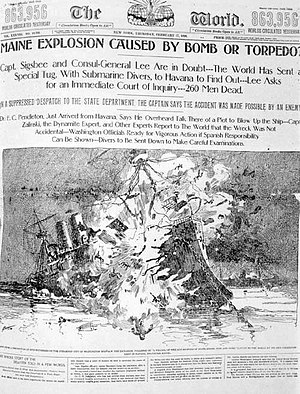At first, Joseph Pulitzer did not have to worry much about competing with other newspapers. He purchased the “New York World” in 1883 and things were going well. Under Pulitzer, the “World” had circulation grow from 15,000 to 600,000. However, things started to change in 1895.
William Randolph Hearst purchased the “New York Journal” and wasted no time in starting a circulation battle. The two papers embellished stories and sometimes made them up all together. This strategy of sensationalizing the news to raise circulation was named “yellow kid” Journalism after a popular cartoon that both papers ran at the time, but was soon shortened to yellow journalism. One of the prime examples is their coverage of the Spanish-American War.
When Hearst heard about tension building in Cuba, he sent an artist down to capture images of the war that was supposedly about to start. However, the artist spent some time in Cuba and could not find the problems he was told to illustrate. He sent a telegraph to Hearst to tell him there were no problems and that there would be no war. Hearst responded by telling him, “You furnish the pictures and I’ll furnish the war.”
The USS Maine exploded on February 15, 1898, and both papers jumped at the opportunity for a story. Despite the fact the cause of the explosion was unknown, the “World” ran a story about the ship being blown up by an enemy torpedo along with a picture of a violent explosion. The “Journal” ran a similar story, claiming they would give a $50,000 reward to anyone with information on the attack. This was obviously just to pull in readers since there was no actual attack on the ship.
However, the pair’s shared reputation of being yellow journalists hurt both of them in the end. Pulitzer began to feel bad about his exaggeration of the news and claimed to be bothered by his “yellow sins”. He spent the rest of his life working toward making the “New York World” a well-respected publication again.
Hearst was an aspiring politician and even looked to gain the Democratic nomination for president at one point. He was unsuccessful because Journal had two different writers print stories suggesting the assassination of President McKinley. Hearst was accused of persuading the assassin to kill McKinley through his yellow journalism and he became irrelevant in the world of politics.



Leave a response